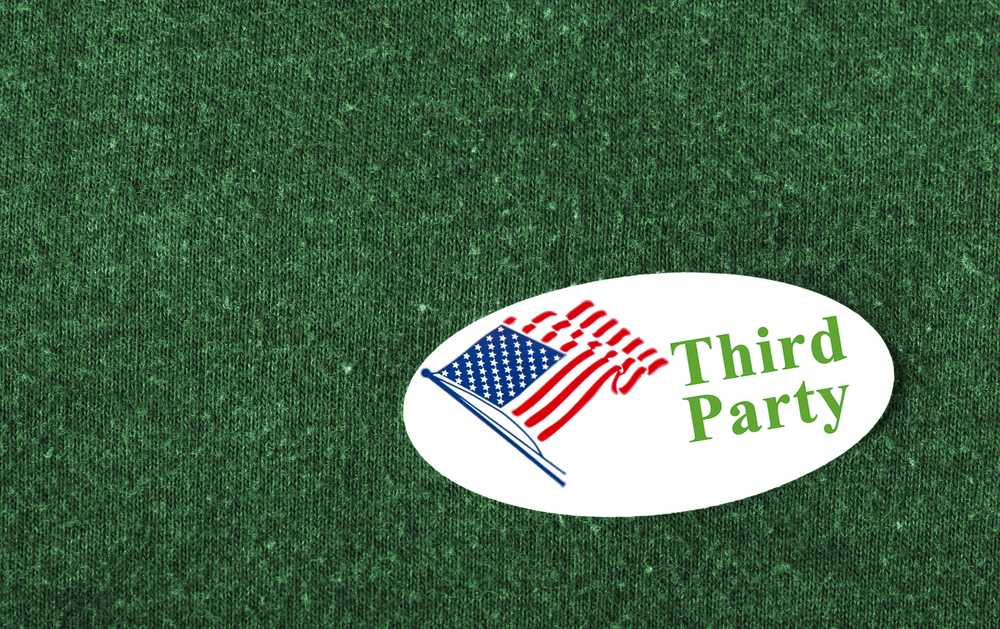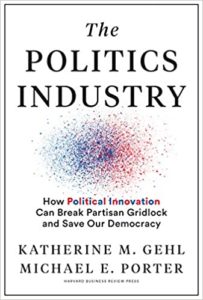How to Break Up the Two-Party Duopoly
By Arnold Kling


- Why is business so good in politics? Why does it work so well for the industry itself but not for everyone else? Only by teasing apart the key rules and practices—the machinery of elections and legislating—that have been set and optimized by the duopoly over generations can we answer these questions and devise solutions to save our democracy.
- —Katherine Gehl and Michael Porter, The Politics Industry: How Political Innovation Can Break Partisan Gridlock and Save Our Democracy.1
Entrepreneur Katherine Gehl and business professor Michael Porter look at American politics as if it were a business case study. In The Politics Industry: How Political Innovation Can Break Partisan Gridlock and Save Our Democracy, they describe politics as a duopoly that is badly serving the ordinary citizens who ought to be its customers. They argue that we need to push for a new set of rules that would make the industry more competitive. In particular, they advocate open primaries with ranked-choice voting.
In America, we have come to treat the two-party system as a sacred tradition, almost as if it were written into the Constitution itself. Gehl and Porter argue instead that the two-party system is a product of the rules for determining the outcome of elections. The two parties have joined forces to ensure that these rules stifle competition.
The malfunctioning duopoly
Many political theorists have supposed that competition between two parties would lead each party toward the center, in pursuit of the “median voter.” But in recent decades, the incentives have led in the other direction. “A political system is supposed to serve the public interest, so all citizens should be its customers. But. . .the duopoly prioritizes. . .party-primary voters, special interests, and donors” (36).
In many Congressional districts, the primary is more important than the general election. In those districts, extreme partisan politics is rewarded and centrist politics is punished. This makes bipartisan legislation impossible, because a representative who votes for such legislation will be branded a traitor and voted out of office in the next primary. “Party-line legislation dominates partly because there simply aren’t enough moderates remaining who can bridge the gap between the extremes of the two sides” (75).
Even on an issue where a bipartisan solution has broad support in the general public, the incentive of each side is to draw a line in the sand and refuse to compromise. On immigration, for example, the Senate passed an immigration reform bill with substantial backing from both Democrats and Republicans.
Unfortunately, it died in the House when Republican Speaker Dennis Hastert invoked his Hastert Rule, refusing to hold a vote on the bill… out of fear that compromising would taint the Republicans’ ideological purity, disappoint their partisan and special-interest bases, and reduce their chances in the midterms (83).
The Hastert Rule was a rule that the Speaker of the House would keep the House from voting on legislation that a majority of his party did not support, even though the overall House, including some members of his party, would have voted for the legislation.
The Hastert Rule is an example of an arbitrary rule that works against compromise and centrism. Another example that Gehl and Porter cite is “sore loser” laws. These are laws that forbid a candidate who loses in a primary from running in a general election. Thus, if an extremist defeats a centrist in a primary, the centrist must refrain from running in the general election, even if he or she has a better chance of winning than the extremist. Gehl and Porter write that forty-four states have such laws.
The Desired State
Gehl and Porter spell out what they see as the desired state of Congressional politics. This would include these characteristics:
- —Effective solutions. These are centrist policies that deal with problems, not perfectly but effectively and with bipartisan support.
- —Action. Partisanship should not produce gridlock in the face of difficult issues.
- —Broad-based buy-in over time. This means that major legislation would have bipartisan support, rather than being rammed through by the party that happens to hold a majority.
- —A balance of short- and long-term needs. Too often, the only bipartisan legislation adds to fiscal deficits and unfunded liabilities.
Final-Five Voting
Gehl and Porter believe that one reform, if enacted in most jurisdictions, would promote centrism, helping to steer Congressional politics toward the desired state. They call this reform final-five voting. “Final-Five Voting consists of two parts—open, single-ballot, nonpartisan primaries, in which the top-five candidates qualify for the general elections. . .and ranked-choice voting in general elections” (127). Ranked-choice voting means that voters mark their choices in order of preference, one through five. Here is one possible algorithm for determining the winner in a general election with five candidates and ranked-choice voting.
First, if a candidate obtains a majority of first-place votes, that candidate is the winner.
Otherwise, take the 5th-place candidate off the ballot, and pretend that you held a run-off among the top four candidates, in which the second-choice votes of those who voted for the 5th-place candidate are allocated to the other four candidates. If one of those candidates now has a majority, that candidate is the winner.
Otherwise, take the 4th-place candidate off the ballot and pretend that you held a run-off among the top three candidates, in which the votes of those who voted for the 4th and 5th place candidates are re-allocated to their top choices among the other three candidates. If one of those three candidates now has a majority, that candidate is the winner.
Otherwise, take the 3rd-place candidate off the ballot and pretend that you held a run-off among the top two candidates, in which the votes of those who voted for the 3rd, 4th, and 5th place candidates are allocated to their top choices among the other two candidates. One of those two candidates will now have a majority and be declared the winner.
Such a system would be more congenial to centrists. In a heavily Democratic district, the primary might result in two or more of the final-five candidates being on the left. In the general election, the more moderate of these candidates would have a better chance of winning than in a two-person Democratic primary. In a general election, the moderate might get more first-place votes. Moreover, even if the extremist gets more votes in the general election, the extremist may not get enough to win the election, and the second-choice votes might swing the election to the moderate.
Such a system also would be more congenial to independents and to third parties. Suppose that you live in a district in which a third-party candidate has little chance of coming in first. Today, the votes for that candidate are unlikely to count. If you really cannot stand one of the major-party candidates, you are afraid to “throw away” your vote, and so you vote for the other major-party candidate, to try to stop the one you really hate.
With ranked-choice voting, if you vote for your third-party preference, you are helping to keep the candidate you hate from winning a majority. And in the pretend run-off, your vote will go to the major-party candidate that you hate less.
Today’s system artificially depresses the votes of third-party candidates relative to the number of voters who prefer them. With ranked-choice voting, third-party candidates would get more votes, and they would be more likely to score breakthroughs and win elections.
If final-five voting worked as intended, it would provide today’s Congressional races with more effective competition from centrists, third parties, and independents. Gehl and Porter argue that this in turn would give Congress the incentive to adopt procedural reforms that would make legislative activity more constructive and effective.
What could go wrong? I worry that final-five voting could produce third parties with veto powers. For example, suppose that there emerged an anti-abortion party that can command 15 percent of the vote. It is likely that no major-party candidate could win election without support of the second-choice votes of this party. So each candidate might commit to banning abortion, even though a majority of voters do not wish to ban abortion. Or you might see a third party committed to banning charter schools, with a similar effect. In short, a well-organized, intense minority might be empowered in final-five voting.
Whatever the risks are with its adoption, final-five voting should not be compared with some political nirvana. Instead, it ought to be evaluated relative to the current situation, and from that perspective it seems like a promising reform.
Footnotes
[1] Katherine M. Gehl and Michael E. Porter, The Politics Industry: How Political Innovation Can Break Partisan Gridlock and Save our Democracy. Harvard Business Review Press, 2020.
*Arnold Kling has a Ph.D. in economics from the Massachusetts Institute of Technology. He is the author of several books, including Crisis of Abundance: Rethinking How We Pay for Health Care; Invisible Wealth: The Hidden Story of How Markets Work; Unchecked and Unbalanced: How the Discrepancy Between Knowledge and Power Caused the Financial Crisis and Threatens Democracy; and Specialization and Trade: A Re-introduction to Economics. He contributed to EconLog from January 2003 through August 2012.
Read more of what Arnold Kling’s been reading. For more book reviews and articles by Arnold Kling, see the Archive.
